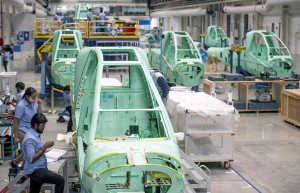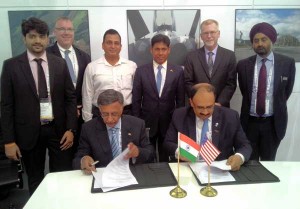
The much publicised Strategic Partnership Model (SPM) launched with a laudable aim to allow the growth of the private sector through the route of Joint Ventures with foreign OEMs failed to deliver initially due to lack of clarity on many issues. The SPM, from the word ‘Go’, was put through so many amendments that it seemed to lose focus. For instance, the very definition of a ‘strategic partner’ saw any number of amendments. All the above put together ensured that while the slogan of Make-in-India made much thunder and noise in the defence manufacturing circles, its translation into ‘orders for the private sector’ remained only a dream.
Just six years ago a critical procurement deal got derailed because the foreign Original Equipment Manufacturer (OEM) could not find suitable private players in India…
Open sources reported on April 07, 2020, that the private sector giant Larsen and Toubro (L&T) has won a ‘large contract’ worth –around Rs. 5,000 crore for establishing a comprehensive unified Network Management System for the Indian Army.[1] A huge success indeed for a firm in the private sector of the Indian defence industry! Compare this with the scenario just six years ago when a critical procurement deal got derailed because the foreign Original Equipment Manufacturer (OEM) could not find suitable private players in India who were ‘technologically matured enough’ to absorb the type of technology offset which it was mandated to be discharged in the private sector. The inability of the OEM to implement the offsets commitment killed the deal.
Around the same time i.e. from 2011 to 2014, the ongoing negotiations with an Israeli OEM for the Medium Range Surface to Air Missile (MRSAM) system ran into a huge work-share problem. The Indian partner was rightfully demanding enhancement in the ‘qualitative content’ of the work-share while one of the many arguments of the OEM was that ‘this level of technology cannot be handled in-house’ by the Indian player. From the state mentioned in the above two incidents till what happened on April 07, 2020, is a long and an uphill journey for the defence private sector – a journey that has been filled with unkept promises, frustration, endless waiting for orders, and also, some occasional bright sparks of successes. This journey can be divided into some distinctly identifiable milestones as under:
• The Slogan Phase
• The Thaw
• Move Forward
• Initial Successes
Long Way Ahead
On September 25 2014, Prime Minister Modi launched the Flagship ‘Make-in-India’ initiative opening some 25 sectors of the Indian economy that included the defence manufacturing sector…
The Slogan Phase
While the history of the defence private sector began in January 2002, when the Government opened defence production to the private sector[2], for most of the early existence, it simply simmered as if to indicate ‘that it is there’ while the complete ecosystem of defence production was anchored on and dominated by the public sector. Besides the Defence Research and Development Organisation (DRDO), it was the Defence Public Sector Undertakings (DPSUs), state-run shipyards and a mammoth Ordnance Factory Board (OFB) with 41 Ordnance Factories (OFs), that shared amongst themselves whatever little the country produced indigenously (a mere 20-30 percent) while the nation held the tag – ‘second largest arms importer of the world’.
For many years, while all the above continued to happen, the defence private sector existed as a non-entity handling some low-end business that got doled out/spilt over from the kitty of the public sector monolith. Something big happened in 2014, when on September 25 that year, Prime Minister Modi launched the Flagship ‘Make-in-India’ initiative opening some 25 sectors of the Indian economy that included the defence manufacturing sector.
The majestic lion made up of machine and industrial parts that stood for ‘Make-in-India’ said it all. It gave a clarion call to foreign investors and OEMs to set up shop in India, increase their investments here and enter into a regime of Joint Ventures (JVs), co-development, co-production with buy back, Transfer of Technology (ToT), Memorandum of Understandings (MoUs) and more.
Much of the spirit of Make-in-India was captured in the Defence Procurement Procedure (DPP) which got launched with much fanfare at the Goa Defence Expo on March 16, 2014. The DPP 16, as it is commonly referred to, set out in the preamble its key aim of ‘building self-reliance’ in defence equipment production and acquisition. It also talked about the core values of ‘fair competition and level playing field’ besides other virtues of probity, accountability and transparency. To walk the talk, the Ministry of Defence (MoD) introduced several new provisions to boost indigenous production. Indigenously Designed Developed and Manufactured (Buy Indian-IDDM) was introduced as Priority 1 categorisation of procurement, innovative ideas like Make 1 and Make 2 procedures with special reservation for the Micro Small and Medium Enterprises (MSMEs) therein (For Make 1 < Rs 10 crore and for Make 2 < Rs 3 crore worth of projects earmarked for MSMEs), unshackling the L1 syndrome by building options in Qualitative Requirements (QRs), eliminating the single vendor phobia and putting forward bold and progressive options like the Strategic Partnership Model (SPM), and so on… the list can go on. But did all the above address the core issue under discussion? Did the private defence industry derive the benefits and the strengths that were envisaged in the Make-in-India initiative? Alas! No.
The private sector players continued to wait for some goodies from the government falling in their laps, but nothing happened at least in the two years that followed the launch of Make-in-India. Some facts are presented:
• Just to state the starting conditions, in the year when Make-in-India got launched, the share of Indian Army’s capital acquisition for the FY 2013-14 was 82.39 percent for the public sector and 1.91 percent for the private sector (the balance being of foreign vendors and other expenditure for which public/private classification is not available).[3]
• The same figures for the Indian Air Force were; public sector 41.84 percent, private -1.47 percent.[4]
For long periods of time in their existence, the DPSUs and the OFs were used to the ‘nomination process’ for orders that avoided all competition…
Nothing much changed in the next financial year and a half:
• In the financial year 2015-2016, the DRDO alone won a total of 78 projects amounting to a whopping 70 percent of all the projects sanctioned, mopping up some Rs 3,723 crore while the total share of the private sector remained a pittance at less than five percent.[5]
For long periods of time in their existence, the DPSUs and the OFs were used to the ‘nomination process’ for orders that avoided all competition. For instance, all orders for the Akash Weapon systems, HAWK jet trainers, SU 30 MKIs went by nomination of a DPSU/OF. While the MoD did institute a major policy change for the defence industry in the FY 2009-2010 by introducing competition in ‘Buy Indian’ and ‘Make India’ categories[6], sadly the ‘mindset’ of the bulk of orders to DPSUs/DRDO/OFs continued well into FY 2015-2016 and 2016-2017. The results were evident in the year-on-year swelling order books of public sector players while the private sector largely remained bereft of any major orders. A case in point: the order book of Bharat Electronics Limited (BEL) increased by a whopping 25 percent to Rs 17,000 crore in the FY 2016-2017[7] while similar growth in the private sector was minimal.
To make things worse, many new and bold initiatives offered in DPP 2016 had a slow and problem-ridden start. A sample: The initial Make-in-India Projects such as the Futuristic Infantry Combat Vehicle (FICV), Tactical Communication System (TCS) and Battle Management System (BMS) had a troubled start and a snail-paced forward movement. Even four years after sanction, these projects did not even reach the development stage – approval and production are another story. In the initial stages, there were many doubts on several aspects of the Make 2 procedures such as modalities of implementing the ‘relaxed criteria’, suo moto proposals, foreclosure of projects and others. The required clarifications from the MoD remained awaited for a long time.
The much publicised Strategic Partnership Model (SPM) launched with a laudable aim to allow the growth of the private sector through the route of JVs with foreign OEMs failed to deliver initially due to lack of clarity on many issues. The SPM, from the word ‘Go’, was put through so many amendments that it seemed to lose focus. For instance, the very definition of a ‘strategic partner’ saw any number of amendments. All the above put together ensured that while the slogan of Make-in-India made much thunder and noise in the defence manufacturing circles, its translation into ‘orders for the private sector’ remained only a dream. This phase which carried on more or less till the end of FY 2016-2017 ultimately turned out to be nothing more than a ‘slogan phase’. Ironically, the biggest culprit for inflicting the ‘slogan phase’ on the private defence sector was not finance, not procedures, not rule books, but ‘an attitudinal mindset’ of the authorities and the decision makers that it is the public sector that will somehow drive defence manufacturing while the private sector was ‘not yet ready’.
Appraised of the “hollowness of Make-in-India” for the private sector in nearly two years of its launch, the Government of India came out with some concrete steps…
The Thaw
The first signs of success post the Make-in-India launch, appeared in the heavy vehicle sector or more appropriately, the High Mobility Vehicle (HMV) sector. Thanks to the imbroglio created in the Bharat Earth Movers Limited (BEML) Tatra vehicles with all the allegations of bribes, kickbacks, bloated up prices and more, the private sector tried to fill the vacuum so created. In some of the earliest successes, in September 2014, L&T bagged a contract for vehicle platforms for Grad BM 21 rocket launcher for Rs 90.89 crore. This was followed by Tata Motors winning a huge contract in March 2015 for supplying 1,239 6×6 HMVs with cranes at Rs 914 crore and Ashok Leyland for 6×6 and 8×8 HMVs at Rs 355 crore.[8]
Right from 2002, when the Indian defence sector was opened up 100 percent to participation by the Indian private sector, the Government mandated the private players to obtain an Industrial Licence (IL). Initially, there was a lot of confusion as to what items will require an IL. Also, against a stipulated period of seven to eight weeks, the grant of ILs took up to two years. Much of these started to ease out in 2016-2017, as the Government stepped in to streamline the IL process. The numbers of IL granted increased sharply. It is no wonder that as of December 2019, a total of 460 ILs had been issued covering some 275 companies.[9],[10] Appraised of the “hollowness of Make-in-India” for the private sector in nearly two years of its launch, the Government of India came out with some concrete steps in the FYs 2017-2018, 2018-2019, 2019-20. Some of these are covered[11]:
• Pursuant to the pro-active initiatives of institutionalised platforms for MoD – Industry interaction (CII, FICCI, PHD Chambers), the Government addressed the lurking doubts in the SPM. It also made efforts to enthuse some life in the Make 1 and Make 2 procedures and tried to live up to the promise of ensuring a semblance of reservations to the MSMEs in Make projects. Resultantly, as of July 2019, some 36 Make 2 projects were given the ‘in principle approval’ by the Government. Also the validity of the IL was enhanced from the earlier three to 15 years with a provision for an extension for another three years.
 • The Government also addressed the loopholes in the Make 2 procedure. These included measures as relaxation of eligibility criteria, minimal documentation and provision for consideration of those proposals which have been suggested suo moto by the industry.
• The Government also addressed the loopholes in the Make 2 procedure. These included measures as relaxation of eligibility criteria, minimal documentation and provision for consideration of those proposals which have been suggested suo moto by the industry.
• The SPM which had got stuck due to many issues ever since its launch in February 2016, moved towards resolution based on a direct push from the Prime Minister’s Office (PMO) itself saying that the private sector must get a significant share of projects and contracts as the ‘public sector alone’ approach has not yielded the desired end-state.
From around 2018 beginning, the move forward of the private sector had started to become visible…
• There were huge insolvents in the SPM such as the question of ensuring competitiveness once a private player has been chosen as a strategic partner for a certain specific sector/role or the misgivings in the fairness/eligibility of the selection process or lack of clarity on the division of work. All these issues were slowly moved towards resolution in a spirit of finding the middle ground.[12]
• In April 2018, the MoD launched an innovative ecosystem for defence-titled Innovation for Defence Excellence (iDEX). The aim was to enhance innovation and technology development in defence and aerospace sector by engaging the private sector, be it big players, start-ups, individual innovators or academia. Two years of iDEX have been a very good going indeed. As of July 2019, some 600 start-ups have been engaged in yielding 44 different solutions in response to many-a-problem statements received from the armed forces.
With all the measures as stated above, the initial ‘NO GO’ stage of the ‘slogan phase’ started to get a move on and the private defence industry started to see a ‘thaw’ happening.
The Move Forward
From around 2018 beginning, the move forward of the private sector had started to become visible. Starting with their minimal share in the defence pie as quoted earlier, it continued to grow steadily. For instance, in the FY 2018-2019, for the defence and aerospace sector, the share of private sector touched Rs 15,000 crore as compared to the public sector share of Rs 63,208 crore.[13] A climb of more than 20 percent in the last two fiscals! In 2019, another significant development took place. In September of that year, the DRDO formulated a policy aimed at ToT. Under its programme titled ‘DRDO-Industry Partnership: Synergy and Growth,’ ToT contracts were signed by the DRDO during the Goa Global Expo and Summit 2019 with 16 Indian companies that included three companies in the start-up mode.[14] The Defence Minister’s delegation to Russia in November 2019 included some 50 Indian companies in a bid to attract Russian partners in JVs and MoUs in order to boost defence production in India.
Initial Successes
From around this time, some initial successes started to happen by ones and twos. Some examples:
• The acquisition of K9 Vajra Self-Propelled Howitzer was a huge contract valued at Rs 4,366 crore. For the first time in history, a bid of this value led by the Indian private sector major, L&T won a global military tender.[15]
This was not all. The contract for the above deal, signed on November 09, 2018, made India proud once again. Out of the 100 K9s that were contracted for, only ten were to be received in Semi-Knocked-Down (SKD) kits from the South Korean OEM Hanwha Land Systems (HTW), the balance 90 were to be made wholly made in India; all in a matter of two years. One can imagine the windfall of opportunities such a contract would bring to the Indian private sector. Surely L&T will not make the K9 all by itself. What about a small time player who supplies a tiny sub-component? Many wheels in many companies will roll.[16]







Very informative article.
Thanks.